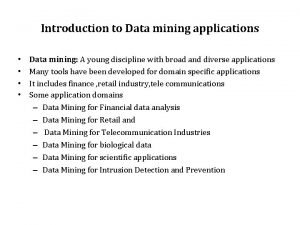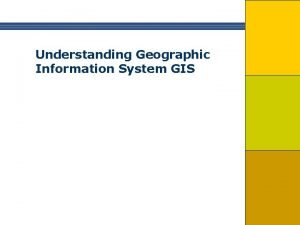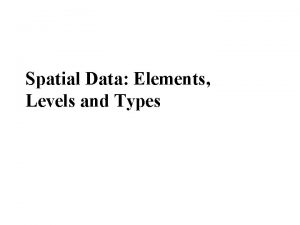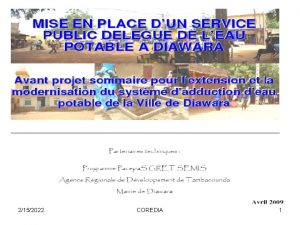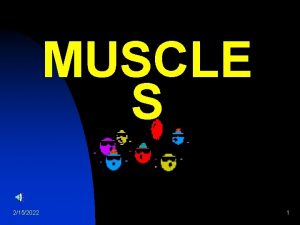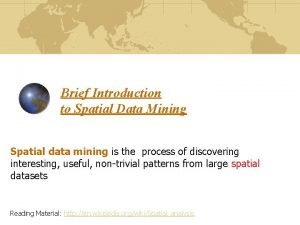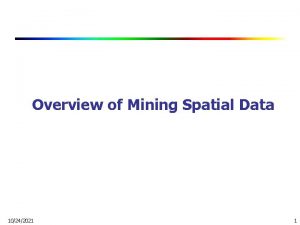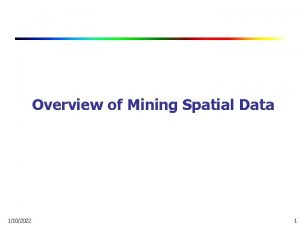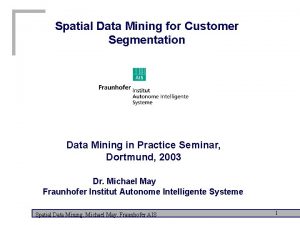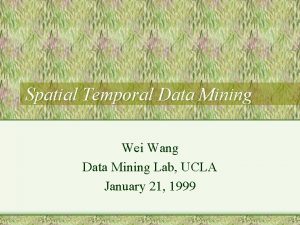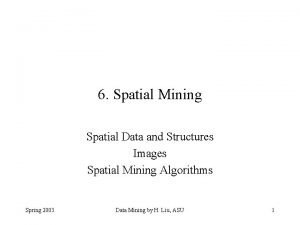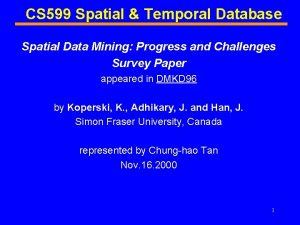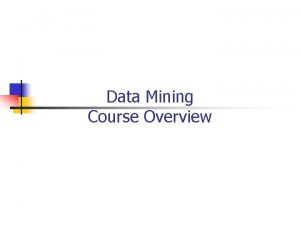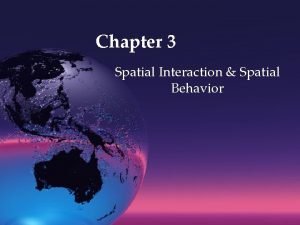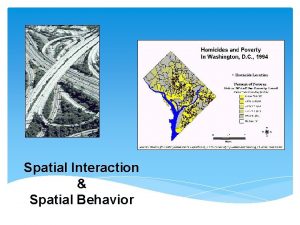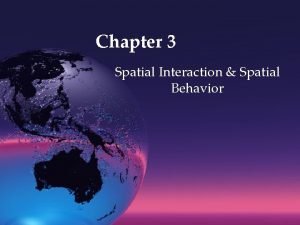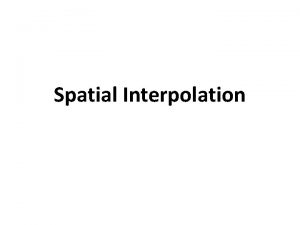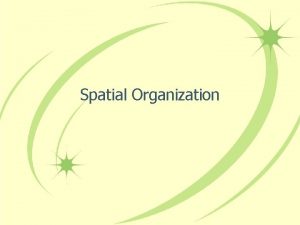Overview of Mining Spatial Data 2152022 1 Mining


















![Spatial Association Analysis n Spatial association rule: A B [s%, c%] n n n Spatial Association Analysis n Spatial association rule: A B [s%, c%] n n n](https://slidetodoc.com/presentation_image_h2/b79f59565700e878f51c70963f3a316c/image-19.jpg)







- Slides: 26

Overview of Mining Spatial Data 2/15/2022 1

Mining Spatial Data n Mining spatial databases and data warehouses 2/15/2022 n Spatial DBMS n Spatial Data Warehousing n Spatial Data Mining n Spatiotemporal Data Mining 2

Generalizing Spatial n Spatial data: n Generalize detailed geographic points into clustered regions, such as business, residential, industrial, or agricultural areas, according to land usage n 2/15/2022 Require the merge of a set of geographic areas by spatial operations 3

What Is a Spatial Database System? n Geometric, geographic or spatial data: space-related data n Example: Geographic space (2 -D abstraction of earth surface), VLSI design, model of human brain, 3 -D space representing the arrangement of chains of protein molecule. n Spatial database system vs. image database systems. n Image database system: handling digital raster image (e. g. , satellite sensing, computer topography), may also contain techniques for object analysis and extraction from images and some spatial database functionality. n Spatial (geometric, geographic) database system: handling objects in space that have identity and well-defined extents, locations, and relationships. 2/15/2022 4

GIS (Geographic Information System) n n 2/15/2022 Analysis and visualization of geographic data Common analysis functions of GIS n Search (thematic search, search by region) n Location analysis (buffer, corridor, overlay) n Terrain analysis (slope/aspect, drainage network) n Flow analysis (connectivity, shortest path) n Distribution (nearest neighbor, proximity, change detection) n Spatial analysis/statistics (pattern, centrality, similarity, topology) n Measurements (distance, perimeter, shape, adjacency, direction) 5

Spatial DBMS (SDBMS) n SDBMS is a software system that supports spatial data models, spatial ADTs, and a query language supporting them n supports spatial indexing, spatial operations efficiently, and query optimization n can work with an underlying DBMS Examples n Oracle Spatial Data Catridge n ESRI Spatial Data Engine 2/15/2022 6

Modeling Spatial Objects n What needs to be represented? n Two important alternative views n Single objects: distinct entities arranged in space each of which has its own geometric description n n modeling cities, forests, rivers Spatially related collection of objects: describe space itself (about every point in space) n modeling land use, partition of a country into districts 2/15/2022 7

Modeling Single Objects: Point, Line and Region n Point: location only but not extent n Line (or a curve usually represented by a polyline, a sequence of line segment): n moving through space, or connections in space (roads, rivers, cables, etc. ) n Region: n Something having extent in 2 D-space (country, lake, park). It may have a hole or consist of several disjoint pieces. 2/15/2022 8

Modeling Spatially Related Collection of Objects n Modeling spatially related collection of objects: plane partitions and networks. n A partition: a set of region objects that are required to be disjoint (e. g. , a thematic map). There exist often pairs of objects with a common boundary (adjacency relationship). n A network: a graph embedded into the plane, consisting of a set of point objects, forming its nodes, and a set of line objects describing the geometry of the edges, e. g. , highways. rivers, power supply lines. n Other interested spatially related collection of objects: nested partitions, or a digital terrain (elevation) model. 2/15/2022 9

Spatial Data Types and Models Field-based model: raster data n framework: partitioning of space n Object-based model: vector model n point, line, polygon, Objects, Attributes n 2/15/2022 10

Spatial Query Language Spatial query language n Spatial data types, e. g. point, line segment, polygon, … n Spatial operations, e. g. overlap, distance, nearest neighbor, … n Callable from a query language (e. g. SQL 3) of underlying DBMS SELECT S. name FROM Senator S WHERE S. district. Area() > 300 n Standards n SQL 3 (a. k. a. SQL 1999) is a standard for query languages n 2/15/2022 11

File Organization and Indices SDBMS: Dataset is in the secondary storage, e. g. disk n Space Filling Curves: An ordering on the locations in a multi-dimensional space n Linearize a multi-dimensional space n Helps search efficiently n 2/15/2022 12

Spatial Query Optimization A spatial operation can be processed using different strategies n Computation cost of each strategy depends on many parameters n n Query optimization is the process of n ordering operations in a query and n selecting efficient strategy for each operation n based on the details of a given dataset 2/15/2022 13

Spatial Data Warehousing n Spatial data warehouse: Integrated, subject-oriented, time-variant, and nonvolatile spatial data repository n Spatial data integration: a big issue n Structure-specific formats (raster- vs. vector-based, OO vs. relational models, different storage and indexing, etc. ) n n Vendor-specific formats (ESRI, Map. Info, Integraph, IDRISI, etc. ) n Geo-specific formats (geographic vs. equal area projection, etc. ) Spatial data cube: multidimensional spatial database n 2/15/2022 Both dimensions and measures may contain spatial components 14

Dimensions and Measures in Spatial Data Warehouse n Dimensions n n n 2/15/2022 non-spatial n e. g. “ 25 -30 degrees” generalizes to“hot” (both are strings) spatial-to-nonspatial n e. g. Seattle generalizes to description “Pacific Northwest” (as a string) spatial-to-spatial n e. g. Seattle generalizes to Pacific Northwest (as a spatial region) n Measures n n numerical (e. g. monthly revenue of a region) n distributive (e. g. count, sum) n algebraic (e. g. average) n holistic (e. g. median, rank) spatial n collection of spatial pointers (e. g. pointers to all regions with temperature of 25 -30 degrees in July) 15

Spatial-to-Spatial Generalization n n 2/15/2022 Generalize detailed geographic points into clustered regions, such as businesses, residential, industrial, or agricultural areas, according to land usage Dissolve Requires the merging of a set of geographic areas by spatial operations Intersect Merge Clip Union 16

Example: British Columbia Weather Pattern Analysis n Input n n Output n n A map that reveals patterns: merged (similar) regions Goals n n A map with about 3, 000 weather probes scattered in B. C. Daily data for temperature, precipitation, wind velocity, etc. Data warehouse using star schema Interactive analysis (drill-down, slice, dice, pivot, roll-up) Fast response time Minimizing storage space used Challenge n 2/15/2022 A merged region may contain hundreds of “primitive” regions (polygons) 17

Star Schema of the BC Weather Warehouse n Spatial data warehouse n Dimensions n region_name n time n temperature n precipitation n Measurements n region_map n area n count Dimension table 2/15/2022 Fact table 18
![Spatial Association Analysis n Spatial association rule A B s c n n n Spatial Association Analysis n Spatial association rule: A B [s%, c%] n n n](https://slidetodoc.com/presentation_image_h2/b79f59565700e878f51c70963f3a316c/image-19.jpg)
Spatial Association Analysis n Spatial association rule: A B [s%, c%] n n n A and B are sets of spatial or non-spatial predicates n Topological relations: intersects, overlaps, disjoint, etc. n Spatial orientations: left_of, west_of, under, etc. n Distance information: close_to, within_distance, etc. s% is the support and c% is the confidence of the rule Examples 1) is_a(x, large_town) ^ intersect(x, highway) ® adjacent_to(x, water) [7%, 85%] 2) What kinds of objects are typically located close to golf courses? 2/15/2022 19

Spatial Autocorrelation n Spatial data tends to be highly self-correlated n Example: Neighborhood, Temperature n Items in a traditional data are independent of each other, whereas properties of locations in a map are often “auto-correlated”. n First law of geography: “Everything is related to everything, but nearby things are more related than distant things. ” 2/15/2022 20

Spatial Trend Analysis n Function n Detect changes and trends along a spatial dimension n Study the trend of non-spatial or spatial data changing with space n Application examples n Observe the trend of changes of the climate or vegetation with increasing distance from an ocean n Crime rate or unemployment rate change with regard to city geo-distribution 2/15/2022 21

Spatial Cluster Analysis n n Mining clusters—k-means, k-medoids, hierarchical, density-based, etc. Analysis of distinct features of the clusters 2/15/2022 22

Constraints-Based Clustering n Constraints on individual objects n n Clustering parameters as constraints n n K-means, density-based: radius, min-# of points Constraints specified on clusters using SQL aggregates n n Simple selection of relevant objects before clustering Sum of the profits in each cluster > $1 million Constraints imposed by physical obstacles n 2/15/2022 Clustering with obstructed distance 23

Constrained Clustering: Planning ATM Locations C 2 e g d Bri C 3 C 1 River Mountain Spatial data with obstacles 2/15/2022 C 4 Clustering without taking obstacles into consideration 24

Mining Spatiotemporal Data n n Spatiotemporal data n Data has spatial extensions and changes with time n Ex: Forest fire, moving objects, hurricane & earthquakes Automatic anomaly detection in massive moving objects n Moving objects are ubiquitous: GPS, radar, etc. n Ex: Maritime vessel surveillance n Problem: Automatic anomaly detection 2/15/2022 25

2/15/2022 26
 Oflinemaps
Oflinemaps Eck
Eck Spatial data mining applications
Spatial data mining applications Trajectory data mining an overview
Trajectory data mining an overview Mining multimedia databases in data mining
Mining multimedia databases in data mining Spatial data and attribute data
Spatial data and attribute data Spatial data and attribute data
Spatial data and attribute data Data cleaning problems and current approaches
Data cleaning problems and current approaches Data quality and data cleaning an overview
Data quality and data cleaning an overview Data quality and data cleaning an overview
Data quality and data cleaning an overview Data reduction in data mining
Data reduction in data mining What is data mining and data warehousing
What is data mining and data warehousing What is missing data in data mining
What is missing data in data mining Data reduction in data mining
Data reduction in data mining Data reduction in data mining
Data reduction in data mining Data reduction in data mining
Data reduction in data mining Shell cube in data mining
Shell cube in data mining Data reduction in data mining
Data reduction in data mining Arsitektur data mining
Arsitektur data mining Perbedaan data warehouse dan data mining
Perbedaan data warehouse dan data mining Mining fraud
Mining fraud Mining complex types of data
Mining complex types of data Olap data warehouse
Olap data warehouse Noisy data in data mining
Noisy data in data mining Olap server architecture in data warehouse
Olap server architecture in data warehouse Markku roiha
Markku roiha Data compression in data mining
Data compression in data mining


